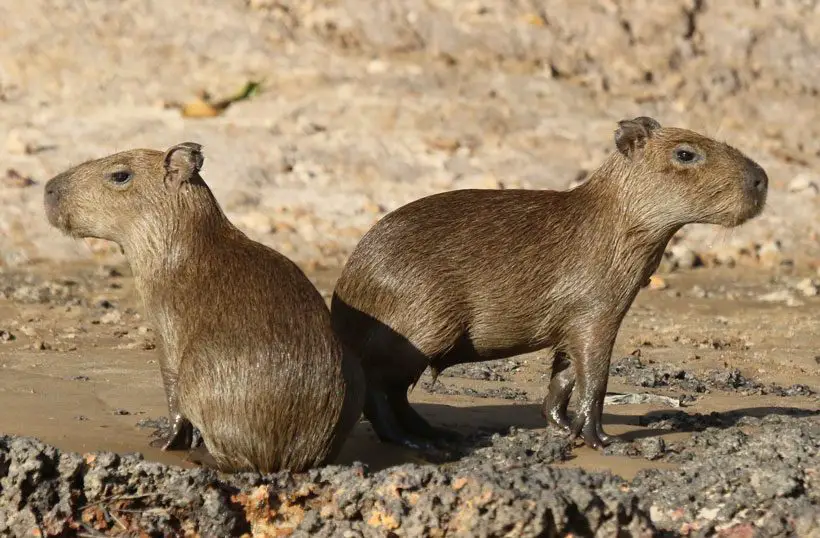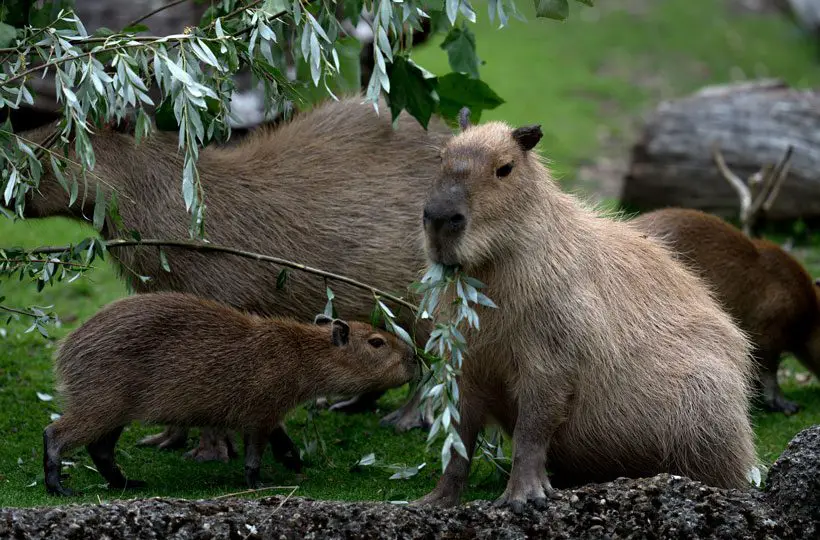Capybara Sounds: What Do These Giant Rodents Sound Like?
Have you ever heard a Capybara sound before? These giant rodents are much more than just adorable creatures – they have a fascinating vocal language that plays a crucial role in their social interactions.
So, what do these giant rodents sound like? Capybaras are renowned for their interesting sounds, which can be heard across their habitats. Capybaras make a variety of sounds, including growls, clicks, barks, and whistles. They also interact through their body language and scent.
In this article, we will go deep into the fascinating world of Capybara sounds, discovering how these giant rodents sound and the significance of their vocalizations. So, let’s get started.
What Kinds Of Sounds Do Capybaras Make?
Did you know Capybaras are very social creatures? They interact with one another using an array of sounds that are crucial to their way of life. Their close-knit community is maintained by the variety of messages they exchange with one another through these noises.

These vocalizations, which might take the form of playful chirps or alarm barks, are essential for maintaining group cohesion and safety. We have included a table below listing the many sounds capybaras make in various situations for your ease of comprehension.
| Different Kinds Of Sounds | Meaning Of The Sounds | Situation When The Sound Is Emitted |
|---|---|---|
| Growling | Aggression/ Fear | When Capybaras fight or compete for dominance. |
| Hissing | Aggression/ Fear | When Capybaras are threatened. |
| Teeth-chattering | Aggression/ Excitement | When they want to show aggression toward potential predators or excitement over food. |
| Whistling | Warning call/ Alarm call | When baby Capybaras sense danger around them. |
| Barking | Warning Call | When Capybaras detect a potential threat |
| Clicking | Contentment | When Capybaras are relaxed. |
| Purring | Contentment | When Capybaras are content and joyful. |
| Chirping | Group communication | When they communicate in a group. |
For Capybaras, their vocalizations are the key to their social interactions, mating behavior, and survival. They use their sounds to convey information about food, predators, and even their emotional state.
Growling Sound
It is well known that Capybaras communicate via a variety of vocalizations. One of their most recognizable vocalizations is the sinister growl they give out when they are engaged in a power struggle or attempting to establish their supremacy over other Capybaras.
This low, deep growl is an undeniable sign of aggression or territorial feelings. Additionally, this sound can also be heard when two Capybaras are squabbling over territory and trying to draw boundaries.
For more information, you can watch this YouTube video.
Hissing Sound
When a Capybara feels threatened or is attempting to assert authority over another, they hiss sharply. They forcibly expel air through their teeth to make this noise, which produces a piercing and menacing sound.
Additionally, Capybaras hiss when they are defining their boundaries or when they are close to one another.
Teeth-chattering Sound
A research paper claims that teeth-chattering is another vocal method used by capybaras to express their feelings. It is interesting that two quite distinct emotions, fear and excitement, can both be associated with teeth-chattering.
It is an indication of anxiety when Capybaras feel threatened or anxious, especially if they detect predators. This teeth-chattering sound can be accompanied by other signs of fear, such as raised hair or a hunched body posture.
However, Capybaras also chitter-chatter their teeth when they are happy, particularly when they anticipate getting their preferred food or treats.
You can watch this YouTube video to find out more about Capybara teeth-chattering sounds.
Whistling Sound
Research has shown that young Capybaras commonly make a distinctive whining or whistling sound throughout the day. Young Capybaras will whistle to warn their moms and other Capybaras of potential danger when they feel frightened or in danger.
Whenever a Capybara is startled or surprised by anything unexpected, it can also make this sound. It is their way of staying in touch and letting their furry friends know that they need to be on high alert and stay vigilant.
If you want to hear a Capybara whistle, check out this YouTube video.
Barking Sound
Capybaras make a series of short and sharp barks, which are meant to warn other Capybaras of the danger that’s lurking around. Fascinatingly, barking is not always an indication of a real threat.
Often, Capybaras will bark as a precautionary measure and then return to grazing or resting once they feel safe again. However, if the danger persists, more animals will start calling, and eventually, they will all gather around in a circle, facing the threat.
In addition to warning calls, Capybaras may also bark when establishing dominance over each other. This sound can often be heard during territorial disputes, where Capybaras are vying for control over a particular space or food.
For more information, check out this YouTube video.
Purring Sound
When Capybaras interact with one another cordially and lovingly, they will purr. This frequently occurs when capybaras are grooming, mating, playing, or just interacting with one another.
Clicking Sound
Capybaras have a unique way of communicating through a vocalization known as a click. This fascinating sound is made up of a series of clicking noises that are created with their teeth.
A recent study has shown that Capybaras use this click sound during aggregating and foraging behaviors, suggesting that it serves as a contact or monitoring call function. This means that Capybaras use the click sound to stay in touch with each other and monitor their surroundings.
Check out this video for more information.
Chirping Sound
Capybaras use chirping as one of their means of communication. The sound of chirping can be heard when Capybaras engage in a variety of group behaviors, including looking for food or moving from one location to another.
The fascinating aspect is that the chirping sound’s can tell us a lot about the behavior of Capybaras. For instance, chirping while moving in a specific direction can indicate that they are heading to a preferred feeding or resting spot.
Furthermore, chirping while searching for food could mean that they have found something particularly alluring.
For more information, watch this YouTube video.
What Part Do Capybara Vocalizations Play In Reproduction And Mating?
Male Capybaras put on quite a show to entice females during the mating season, which normally peaks from April to June. They make an audible barking noise known as a “copulatory call” that may be heard up to 400 meters distant.
This is how they let females know they are prepared for a mating relationship. You might then wonder, what about the female Capybaras? During the mating phase, they each have their unique communication method.
Female Capybaras make a softer sound called a “whistle,” which is supposed to indicate that they are ready to mate. It is interesting to note that this sound may also aid in coordinating mating among several females.

After mating, female capybaras use a different set of vocalizations to communicate with their offspring and other members of their social group.
They produce a series of grunts and clicks that are believed to play a vital role in maintaining social bonds and establishing a sense of authority within the group.
If you’re interested in learning more about capybara swimming, you might find our article on capybara swimming interesting. It delves into the natural swimming abilities of capybaras, their adaptations for an aquatic lifestyle, and their enjoyment of being in the water. Additionally, if you want to know more about the behavior and temperament of capybaras, our article on whether capybaras are dangerous explores their typically docile and gentle nature, while also discussing some factors to consider when interacting with them.FAQs
We have included some frequently asked questions so you may learn more about capybara sounds.
Q: Do capybaras have good hearing?
Yes, Capybaras can hear well and distinguish between a wide range of noises. This is essential for their survival since they must be able to hear predators and other possible threats.
Q: When do capybaras normally make noise?
Although Capybaras can make noise at any time, they are most vocal during the breeding season and whenever they feel threatened or in danger. Additionally, they communicate frequently when they are with others or when they are taking care of their young.
Q: How do baby Capybaras interact with other Capybaras?
Young Capybaras may rely more on physical contact, such as playing or huddling together, to establish social bonds. As they mature, Capybaras become more vocal and use scent marking to assert their dominance or attract mates.
Final Words
In conclusion, Capybara sounds are an intriguing component of the behavior of these enormous rodents that many people may not be aware of. These sociable animals have a sophisticated interacting system, with each sound serving a distinct meaning and function.
For instance, the chattering sound indicates a cordial encounter, whereas the alarm call warns other Capybaras of impending danger. Understanding these Capybara vocalizations can help us better comprehend their social dynamics and behavior.
Capybaras are becoming more common as exotic pets or farm animals. Hence it is crucial to familiarize yourself with their specific traits, especially their vocalizations.
Knowing this will help us to better care for and enhance the lives of these animals while they are in captivity. Furthermore, we can gain more knowledge about them in their natural habitats.




